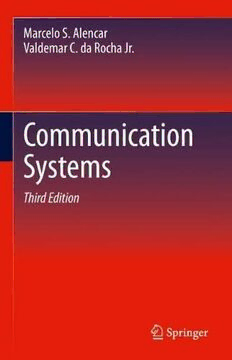
Communication Systems PDF
Preview Communication Systems
Marcelo S. Alencar Valdemar C. da Rocha Jr. Communication Systems Third Edition Communication Systems Marcelo S. Alencar • Valdemar C. da Rocha Jr. Communication Systems Third Edition MarceloS.Alencar ValdemarC.daRochaJr. InstituteofAdvancedStudiesin InstituteofAdvancedStudiesin Communications Communications Salvador,Paraíba,Brazil Recife,Pernambuco,Brazil ISBN978-3-031-12066-4 ISBN978-3-031-12067-1 (eBook) https://doi.org/10.1007/978-3-031-12067-1 1stedition:©SpringerScience+BusinessMedia,Inc.2005 2ndedition:©SpringerNatureSwitzerlandAG2020 ©TheEditor(s)(ifapplicable)andTheAuthor(s),underexclusivelicensetoSpringerNatureSwitzerland AG2022 Thisworkissubjecttocopyright.AllrightsaresolelyandexclusivelylicensedbythePublisher,whether thewholeorpartofthematerialisconcerned,specificallytherightsoftranslation,reprinting,reuse ofillustrations,recitation,broadcasting,reproductiononmicrofilmsorinanyotherphysicalway,and transmissionorinformationstorageandretrieval,electronicadaptation,computersoftware,orbysimilar ordissimilarmethodologynowknownorhereafterdeveloped. Theuseofgeneraldescriptivenames,registerednames,trademarks,servicemarks,etc.inthispublication doesnotimply,evenintheabsenceofaspecificstatement,thatsuchnamesareexemptfromtherelevant protectivelawsandregulationsandthereforefreeforgeneraluse. Thepublisher,theauthors,andtheeditorsaresafetoassumethattheadviceandinformationinthisbook arebelievedtobetrueandaccurateatthedateofpublication.Neitherthepublishernortheauthorsor theeditorsgiveawarranty,expressedorimplied,withrespecttothematerialcontainedhereinorforany errorsoromissionsthatmayhavebeenmade.Thepublisherremainsneutralwithregardtojurisdictional claimsinpublishedmapsandinstitutionalaffiliations. ThisSpringerimprintispublishedbytheregisteredcompanySpringerNatureSwitzerlandAG Theregisteredcompanyaddressis:Gewerbestrasse11,6330Cham,Switzerland Thisbookisdedicatedtoourfamilies. Preface This book is the result of several years of teaching and research at the Federal University of Campina Grande, Federal University of Pernambuco, and Federal University of Bahia, Brazil. It is intended to serve as a textbook for courses dealing with communication systems, cellular mobile systems, or modulation theory.Modulationtheoryisdealtwithusingstochasticprocesses,whichremainsa novelapproachforundergraduatetexts.Thebookissuitablefortheundergraduate aswellastheinitialgraduatelevelsofelectricalengineeringcourses. Chapter 1 covers signal and Fourier analysis and presents an introduction to Fourier transform, convolution, and definitions of autocorrelation and power spectraldensity.Chapter2introducestheconceptsofprobability,randomvariables, andstochasticprocessesandtheirapplicationstotheanalysisoflinearsystems. SpeechcodingisdealtwithinChap.3,whichalsodealswithdigitizingofanalog signals,quantization,andcodingforsignalcompression.Chapter4presentsampli- tude modulation with random signals, including digital signals and performance evaluationmethods. Quadratureamplitudemodulationusingrandomsignals,includingSSB,QUAM, QAM, and QPSK, is the subject of Chap.5. Chapter 6 explains angle modulation withrandommodulatingsignals,includingfrequencyandphasemodulation,FSK, andPSK. Channel modeling is the subject of Chap.7, which includes channel charac- teristics and propagation. Chapter 8 deals with transmission and reception of the modulated carrier, and presents several features of the transmitting and receiving equipment. Thenewconceptofepidemicinterference,basedonnon-stationaryinterference, is presented in Chap.9, which is useful to estimate the effect caused by a sudden attemptbymanyuserstoaccessamobilecommunicationsystem. Chapter10presentsthemainconceptsofmobilecommunicationsystems,both analog and digital. The Long-Term Evolution cellular communication system is presented in Chap.11. The fifth generation of mobile communications (5G) is introducedinChap.12. vii viii Preface Thebookhasfiveappendices.AppendixAcoversFourierseriesandtransforms, Hilbert transform, and their properties. Appendix B presents formulas used in the text. Appendix C shows tables of the radio-frequency spectrum. Appendix D presentstheCDMAcellularsystem.AppendixEpresentstheGSMcellularsystem. Animportantfeatureofthebookisrelatedtothemanyexamplesandproblemsto befoundthroughoutthetext. Salvador,Brazil MarceloS.Alencar Recife,Brazil ValdemarC.daRochaJr. Acknowledgments The authors are grateful to Professor Elvino S. Sousa (University of Toronto, Canada); Professor Paddy Farrell, Professor Bahram Honary, and Professor Garik Markarian (Lancaster University, UK); and Professor Michael Darnell (University of York, UK) for technical communications and useful discussions related to communicationsystems. TheauthorsarealsogratefultoallthemembersoftheCommunicationsResearch Groups, certified by the Brazilian National Council for Scientific and Techno- logical Development (CNPq), at Federal University of Bahia, Federal University of Campina Grande, Senai Cimatex (Salvador, Bahia), and Federal University of Pernambuco, for their collaboration in many ways, helpful Discussions, and friendship, as well as our colleagues at the Institute for Advanced Studies in Communications(Iecom). The authors wish also to acknowledge the contribution of Dr. Raissa Bezerra Rocha(FederalUniversityofSergipe),whocontributedthechapteronLong-Term Evolution;Dr.FranciscoMadeiro(StateUniversityofPernambuco)andDr.Waslon T.A.Lopes(FederalUniversityofParaíba),whocontributedthechapteronspeech coding;andDr.JoelEugênioCordeiroJr.(BahianFederalInstituteofTechnology), whocontributedthechapteronepidemicinterference,andthesupportofThiagoT. Alencar,whohelpedwiththetranslationofselectedofpartsofthetext. The authors are indebted to their families for their patience and support during thecourseofthepreparationofthisbook. Finally,theauthorsarethankfultoMaryE.James,ZoeKennedy,AlexGreene, and Melissa Guasch, from Springer, who strongly supported this project from the beginningandhelpedwiththereviewingprocess. ix Contents 1 SignalAnalysis.............................................................. 1 1.1 Introduction ......................................................... 1 1.2 FourierAnalysis .................................................... 1 1.2.1 TheTrigonometricFourierSeries....................... 3 1.2.2 EvenFunctionsandOddFunctions..................... 5 1.2.3 TheCompactFourierSeries............................. 6 1.2.4 TheExponentialFourierSeries ......................... 7 1.3 FourierTransform................................................... 9 1.3.1 BilateralExponentialSignal ............................ 10 1.3.2 GateFunction............................................ 11 1.3.3 ImpulseFunctionorDirac’sDeltaFunction............ 13 1.3.4 TheConstantFunction .................................. 14 1.3.5 FourierTransformofSineandtheCosine.............. 15 1.3.6 TheFourierTransformofejω0t ......................... 15 1.3.7 TheFourierTransformofaPeriodicFunction......... 16 1.4 SomePropertiesoftheFourierTransform......................... 17 1.4.1 Linearity.................................................. 17 1.4.2 Scaling.................................................... 18 1.4.3 Symmetry ................................................ 19 1.4.4 TimeDomainShift ...................................... 20 1.4.5 FrequencyDomainShift................................. 20 1.4.6 DifferentiationintheTimeDomain..................... 20 1.4.7 IntegrationintheTimeDomain......................... 21 1.4.8 TheConvolutionTheorem............................... 22 1.5 TheSamplingTheorem............................................. 24 1.6 Parseval’sTheorem ................................................. 27 1.7 Average,Power,andAutocorrelation.............................. 28 1.7.1 TimeAutocorrelationofSignals........................ 29 1.8 Problems ............................................................ 32 xi xii Contents 2 ProbabilityTheoryandRandomProcesses ............................. 41 2.1 SetTheory,FunctionsandMeasure................................ 41 2.2 ProbabilityTheory.................................................. 48 2.3 RandomVariables................................................... 52 2.3.1 AverageValueofaRandomVariable................... 53 2.3.2 MomentsofaRandomVariable......................... 53 2.3.3 TheVarianceofaRandomVariable .................... 54 2.3.4 TheCharacteristicFunctionofaRandomVariable.... 54 2.4 StochasticProcesses................................................ 59 2.5 LinearSystems...................................................... 72 2.6 MathematicalFormulationfortheDigitalSignal ................. 81 2.6.1 AutocorrelationfortheDigitalSignal .................. 81 2.6.2 PowerSpectralDensityfortheDigitalSignal.......... 82 2.7 Problems ............................................................ 85 3 SpeechCoding .............................................................. 97 3.1 Introduction ......................................................... 97 3.2 SignalCoding—Preliminaries ..................................... 98 3.3 ThePerformanceofaSignalCompressionSystem............... 99 3.3.1 QualityoftheReconstructedSignals................... 99 3.3.2 BitRate................................................... 102 3.3.3 Complexity............................................... 102 3.3.4 CommunicationDelay................................... 102 3.4 FeaturesofSpeechSignals......................................... 103 3.5 PulseCodeModulation............................................. 106 3.5.1 UniformQuantization ................................... 108 3.5.2 QuantizationNoise ...................................... 108 3.6 NoiseSpectrumfortheUniformQuantizer ....................... 111 3.6.1 NonuniformQuantization ............................... 115 3.7 VectorQuantization................................................. 119 3.7.1 LBGAlgorithm.......................................... 121 3.8 LPCParameters..................................................... 122 3.8.1 LPCQuantization........................................ 123 3.9 OverviewofSpeechCoding........................................ 125 3.10 WaveformCoding................................................... 126 3.11 ParametricandHybridCoding..................................... 128 3.12 SpeechCoderAttributes............................................ 132 3.13 Problems ............................................................ 134 4 AmplitudeModulation..................................................... 135 4.1 Introduction ......................................................... 135 4.2 AmplitudeModulation ............................................. 136 4.3 AmplitudeModulationbyRandomSignals....................... 140 4.3.1 TotalPowerofanAMCarrier........................... 141 4.3.2 PowerSpectralDensity.................................. 141
